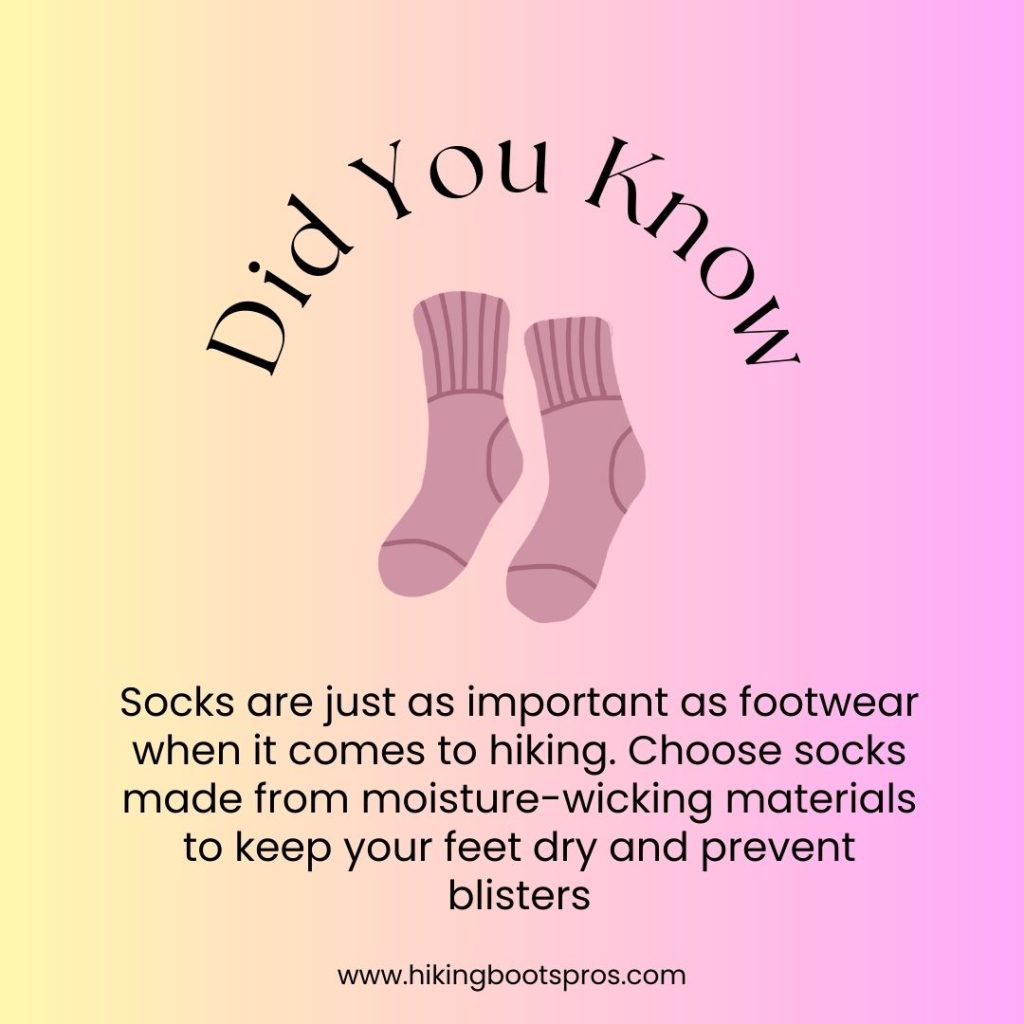Last updated on May 8th, 2023
Hiking is an amazing way to get out in nature and enjoy the great outdoors. However, hiking can be tough on your feet, which is why it’s important to prepare your feet for your next hike.
In this blog post, we’ll cover everything you need to know about preparing your feet for hiking, including how to assess your foot health, how to choose the right footwear, and whether stretching and strengthening exercises are beneficial.
So, if you’re planning a hiking trip soon, keep reading to learn how to keep your feet in top condition.
How Do I Prepare My Feet for Hiking?
Preparing your feet for hiking is crucial to ensure that you have an enjoyable and safe experience. Here are some tips to help you get started:
One of the best ways to prepare your feet for hiking is by conditioning them. Start by walking on different terrain and gradually increase your distance and elevation. This will help to build up the muscles in your feet and ankles, making them more resistant to injury.
Invest in quality footwear: Choosing the right footwear is essential for hiking. Look for shoes that are specifically designed for hiking, with good ankle support and sturdy soles. Make sure they fit well and are broken in before your hike to prevent blisters and other foot problems.

Socks are just as important as footwear when it comes to hiking. Choose socks made from moisture-wicking materials to keep your feet dry and prevent blisters. It’s also a good idea to bring extra pairs of socks with you on your hike in case your feet get wet.
Take care of your feet: Before your hike, make sure to trim your toenails and moisturize your feet to prevent dryness and cracking. If you’re prone to blisters or calluses, consider using moleskin or special blister pads to protect your feet.
How to Assess Your Foot Health?
Assessing your foot health is an important step in preparing for a hike. Here’s what you need to know:
The importance of assessing your foot
Assessing your foot health can help you identify potential problems and prevent them from becoming more serious. By knowing your foot type, you can choose the right footwear and socks to support your feet and prevent injuries.
Common foot problems and how to prevent
Some common foot problems that hikers may encounter include blisters, calluses, and plantar fasciitis. To prevent blisters and calluses, make sure to wear well-fitting shoes and socks, and consider using moleskin or blister pads. Plantar fasciitis can be prevented by stretching your feet and calves regularly and wearing shoes with good arch support.
When to seek medical advice
If you experience foot pain, swelling, or other unusual symptoms during or after a hike, it’s important to seek medical advice. These symptoms could indicate a more serious foot problem that requires treatment. Don’t hesitate to see a doctor or podiatrist if you’re experiencing foot pain or discomfort.
How to Choose the Right Footwear?
When it comes to hiking, having the right footwear can make all the difference. Not only can it help you avoid injuries and discomfort, but it can also improve your overall hiking experience. With so many options available, it can be challenging to know which type of hiking footwear is best for you. In this section, we’ll explore different types of hiking footwear and how to choose the right size and fit.
Different Types of Hiking Footwear
There are several types of hiking footwear available, each with its own benefits and drawbacks. The four most common types of hiking footwear are: Hiking shoes are low-cut and lightweight, making them an excellent choice for day hikes or trails with minimal elevation gain. They’re designed to provide adequate traction and stability on rocky or uneven terrain. However, they offer less ankle support than other types of footwear
Hiking boots are a more robust and supportive option than hiking shoes. They come in a variety of heights, from low-cut to high-cut, and are ideal for hikes with significant elevation gain or rough terrain. They offer excellent ankle support and can help prevent ankle injuries.
However, they tend to be heavier and less breathable than hiking shoes. Trail running shoes are similar to hiking shoes but are designed for speed and agility. They offer less support than hiking shoes or boots but are more flexible, allowing for quick movements and agility on the trail. They’re ideal for day hikes or trail running.
Right Size and Fit
Choosing the right size and fit is essential when it comes to hiking footwear. Ill-fitting shoes can cause discomfort, blisters, and even injuries. Here are a few tips to help you choose the right size and fit:
Your feet tend to swell throughout the day, so it’s best to try on shoes in the afternoon when your feet are at their largest. Make sure to wear the socks you plan on hiking in when trying on shoes. This will give you a better idea of how the shoes will fit during your hike.
There should be enough room in the toe box for your toes to wiggle comfortably. Your heel should be snug but not tight, with no slipping. Take a few steps around the store to get a feel for the shoes. Make sure they feel comfortable and supported.
Once you’ve purchased your new hiking shoes, it’s essential to break them in before hitting the trail. Wear them around the house or on short walks to help them mold to your feet.
By following these tips, you can find the perfect pair of hiking shoes or boots to keep your feet comfortable and protected during your hike.
Is Stretching and Strengthening Exercises Good for Hiking?
If you’re planning a hiking trip, it’s essential to prepare your body, especially your feet. While hiking is an enjoyable activity, it can be physically demanding and lead to injuries if you’re not adequately prepared. One of the best ways to prepare for hiking is through stretching and strengthening exercises.
How to Stretch?
Stretching is an important part of preparing for any physical activity, including hiking. It helps improve flexibility, range of motion, and blood flow, which reduces the risk of injury. Before you start any exercise, it’s essential to warm up first. A proper warm-up can help prepare your muscles for activity and reduce the risk of injury.
When stretching, it’s crucial to do it properly to avoid causing more harm than good. Here are some tips for stretching: Stretch when your muscles are warm: Cold muscles are more prone to injury, so it’s best to stretch after a warm-up or after a shower or bath.
Hold each stretch for at least 30 seconds: This allows your muscles to fully relax and stretch. Don’t bounce. Bouncing can cause muscle tears or strains. Take deep breaths while stretching to help your muscles relax.
Exercises for Hikers
Strengthening exercises can help improve your overall fitness and reduce the risk of injury while hiking. Here are some exercises you can do to strengthen your muscles:
Doing lunges is best for hikers. Stand with your feet hip-width apart and step forward with your right foot. Bend your right knee and lower your body until your right thigh is parallel to the ground. Push back up to the starting position and repeat with your left foot. Repeat 10 to 15 times on each leg.
Next is Squats. Stand with your feet shoulder-width apart and lower your body as if you were sitting in a chair. Keep your back straight and your knees over your feet. Push back up to the starting position and repeat 10 to 15 times.
By incorporating stretching and strengthening exercises into your hiking preparation routine, you can reduce the risk of injury and increase your overall fitness, making your hiking trip more enjoyable.
Read more about: Why do my toes go numb in hiking boots
Conclusion
Taking care of your feet before, during, and after your hike is essential for a successful and enjoyable experience. By preparing your feet through conditioning, assessing your foot health, choosing the right footwear, and doing stretching and strengthening exercises, you can prevent common foot problems and enjoy your hike to the fullest.
Remember to prioritize foot hygiene, wear breathable socks, and seek medical advice if necessary. Happy hiking!
FAQs
To prevent blisters and other foot injuries while hiking, you should wear properly fitting and supportive hiking boots, break them in before the trip, use moisture-wicking socks, apply foot powder or lubricant, and take breaks to rest your feet and air them out.
To care for your feet before and after hiking, you should trim your toenails, moisturize your feet, wear comfortable and breathable socks and shoes, stretch and massage your feet, elevate them to reduce swelling, and treat any blisters or injuries promptly.

Tyler Looney is an avid hiking enthusiast and the author of HikingBootsPros.com, a website dedicated to providing helpful insights and advice on choosing the best hiking boots. His expertise and passion for hiking have made him a valuable resource for both beginner and experienced hikers alike.

